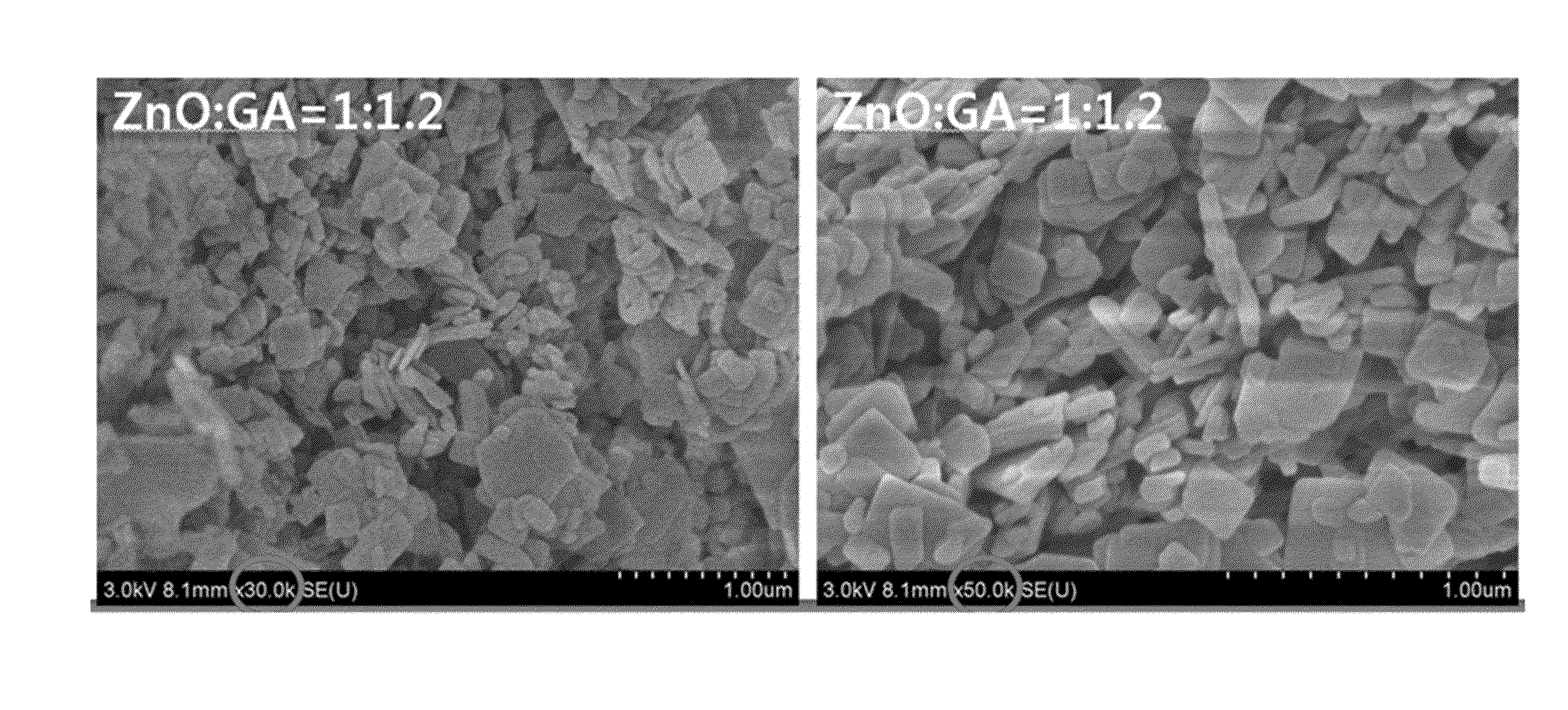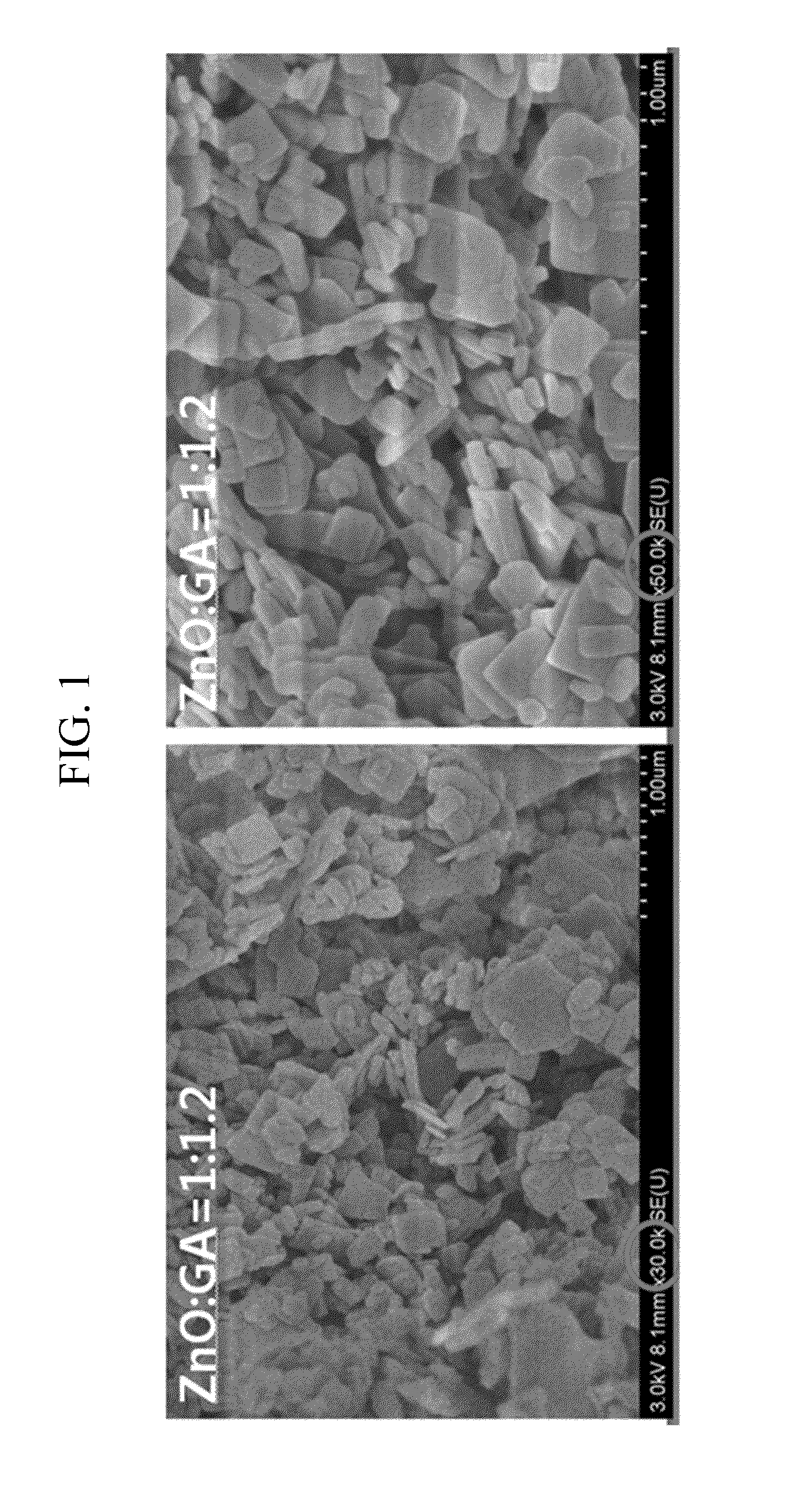Manufacturing method of organic zinc catalyst and manufacturing method of polyalkylene carbonate resin
a technology of organic zinc and manufacturing method, which is applied in the preparation of organic compounds, carboxylic compound preparations, chemical process catalysts, etc., can solve the problems of difficult control of zinc dicarboxylate-based catalysts having crystalline particle shapes, increasing carbon dioxide concentration in the atmosphere, and increasing the difficulty of increase, etc., to achieve uniform and fine particle size, excellent activity
- Summary
- Abstract
- Description
- Claims
- Application Information
AI Technical Summary
Benefits of technology
Problems solved by technology
Method used
Image
Examples
example 1
Manufacture of Organic Zinc Catalyst (Molar Ratio of ZnO and Glutaric Acid=1:1.2)
[0050]7.93 g (0.06 mol) of a glutaric acid and 0.1 mL of acetic acid were added to 100 mL toluene in a 250 mL size round bottom flask, and dispersed under reflux. Then, the mixture was heated at a temperature of 55° C. for 30 minutes, and 4.1 g (0.05 mol) of ZnO was added to 50 mL of toluene, and dispersed. The reaction was performed by firstly adding 25 vol% of the ZnO dispersion liquid to the glutaric acid dispersion liquid, then after 1 hour, adding another 25 vol % out of 75 vol % of the ZnO dispersion liquid to the glutaric acid dispersion liquid, and after 1 hour, adding the third 25 vol % of the ZnO dispersion liquid to the glutaric acid dispersion liquid. Next, after 1 hour, the other 25 vol % of the ZnO dispersion liquid was lastly added to the glutaric acid dispersion liquid. The mixed solution was heated at 110° C. for 2 hours. A white solid was produced, filtered and washed with acetone / etha...
example 2
Manufacture of Organic Zinc Catalyst (Molar Ratio of ZnO and Glutaric Acid=1:1.5)
[0052]9.91 g (0.075 mol) of a glutaric acid and 0.1 mL of acetic acid were added to 100 mL toluene in a 250 mL size round bottom flask, and dispersed under reflux. Then, the mixture was heated at a temperature of 55° C. for 30 minutes, and 4.1 g (0.05 mol) of ZnO was added to 50 mL of toluene, and dispersed. The reaction was performed by firstly adding 25 vol % of the ZnO dispersion liquid to the glutaric acid dispersion liquid, then after 1 hour, adding another 25 vol % out of 75 vol % of the ZnO dispersion liquid to the glutaric acid dispersion liquid, and after 1 hour, adding the third 25 vol % of the ZnO dispersion liquid to the glutaric acid dispersion liquid. Next, after 1 hour, the other 25 vol % of the ZnO dispersion liquid was lastly added to the glutaric acid dispersion liquid. The mixed solution was heated at 110° C. for 2 hours. A white solid was produced, filtered and washed with acetone / et...
example 3
Manufacture of Organic Zinc Catalyst (Molar Ratio of ZnO and Glutaric Acid=1:1)
[0054]6.61 g (0.05 mol) of a glutaric acid and 0.1 mL of acetic acid were added to 100 mL toluene in a 250 mL size round bottom flask, and dispersed under reflux. Then, the mixture was heated at a temperature of 55° C. for 30 minutes, and 4.1 g (0.05 mol) of ZnO was added to 50 mL of toluene, and dispersed. The reaction was performed by firstly adding 25 vol % of the ZnO dispersion liquid to the glutaric acid dispersion liquid, then after 1 hour, adding another 25 vol % out of 75 vol % of the ZnO dispersion liquid to the glutaric acid dispersion liquid, and after 1 hour, adding the third 25 vol % of the ZnO dispersion liquid to the glutaric acid dispersion liquid. Next, after 1 hour, the other 25 vol % of the ZnO dispersion liquid was lastly added to the glutaric acid dispersion liquid. The mixed solution was heated at 110° C. for 2 hours. A white solid was produced, filtered and washed with acetone / ethan...
PUM
| Property | Measurement | Unit |
|---|---|---|
| particle size | aaaaa | aaaaa |
| particle size | aaaaa | aaaaa |
| temperature | aaaaa | aaaaa |
Abstract
Description
Claims
Application Information
 Login to View More
Login to View More - R&D
- Intellectual Property
- Life Sciences
- Materials
- Tech Scout
- Unparalleled Data Quality
- Higher Quality Content
- 60% Fewer Hallucinations
Browse by: Latest US Patents, China's latest patents, Technical Efficacy Thesaurus, Application Domain, Technology Topic, Popular Technical Reports.
© 2025 PatSnap. All rights reserved.Legal|Privacy policy|Modern Slavery Act Transparency Statement|Sitemap|About US| Contact US: help@patsnap.com



